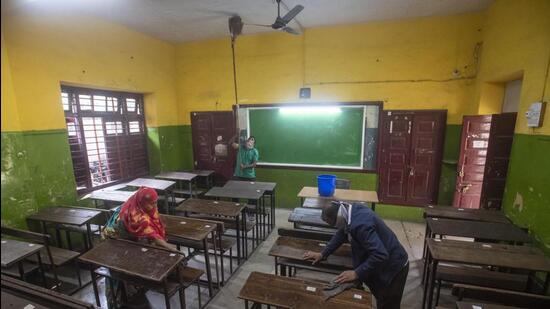Around 20,000 schools shut in 2nd year of Covid-19: Report
About 20,000 schools, both private and government, were shut down across the country in the second year of the Covid-19 pandemic (2021-22), a report by the Union education ministry said on Thursday.
About 20,000 schools, both private and government, were shut down across the country in the second year of the Covid-19 pandemic (2021-22), a report by the Union education ministry said on Thursday.

The report highlighted that the enrolment of students in private schools continued to decline across the country, while it increased in government schools in the 2021-22 academic year. The drop-out rate among students of classes 1 to 8 increased in 2021-22 by almost double in comparison to 2020-21, it added.
According to the Unified District Information System for Education (UIDSE+) report, prepared on the basis of data provided by both government and private schools voluntarily, while the number of schools across the country in 2020-21 stood at 1,509,136, it declined to 1,489,115 in 2021-22.
“The decline in total schools is mainly due to closure of private and ‘other management’ schools,” the report stated.
A closer look at the data showed that of the 20,021 schools that were shut down, 9,663 were government-run, 1,815 government-aided, 4,909 private and 3,634 were under the “other managements” categories. The data reiterated the anecdotal evidence of closure of schools, especially budget-friendly schools, amid the Covid-19 pandemic.
Also read: Chandigarh tricity saw 68% drop in Covid-19 cases in October
“The reason behind closure of government schools in some states is due to the grouping/clustering of existing schools,” said a senior ministry official, asking not to be named.
In terms of state-wise break-up, the states where large numbers of schools were shut down in the second pandemic year included Madhya Pradesh (7,689), Odisha (1,894), Andhra Pradesh (1,395), Uttar Pradesh (1143), Punjab (994), and Maharashtra (509).
Bharat Arora, president, action committee of unaided private schools in Delhi, said the figures are not surprising, and the actual numbers could be higher. “The financial crunch due to Covid-19 crisis and subsequent lockdowns has led to this situation. Further, the private school community across the country did not receive any support from the government,” he said. “This is high time for all authorities and policymakers — both at state and the central government levels — to think seriously about it and to extend a positive support to this community.”
The UDISE+ report also highlighted that the enrolment in private schools continued to decline while the number of students joining government schools increased. Experts said it implied that private school students continued to join government schools as a result of financial constraints wrought by the pandemic.
Educationist Meeta Sengupta said the trend indicated both movement of students from private to government schools and also students dropping out. “While the drop-out rate at primary and upper primary levels may recover soon, those in classes 10 to 12 may not come back to schools,” she said. “Many of those who missed out on their school leaving examination years found it necessary to carry on with their lives for starting work or families.”
According to the UDISE+ 2020-21 report released in March this year, the number of students enroled in private schools decreased from 98 million in 2019-20 to 95 million in 2020-21, while enrolment in government schools rose by 3.97 million to 132,425,644 during the same period. In 2021-22, the number of students enrolled in private schools decreased to 88 million, while enrolment in government schools increased by 8.3 million.
The report highlighted that the drop-out rate among younger students increased in 2021-22 in comparison to 2020-21. While the drop-out rate among children enroled in primary classes (1-5) increased to 1.5% from 0.8%, at the upper primary level (6-8), it went up to 3% from 1.9% in 2020-21.
Also read: China locks down area around world's largest iPhone factory after Covid spike
The report stated that even as the overall enrolment of students in schools across the country increased by 1.93 million as compared to 2020-21, the enrolment in pre-primary sections of school dropped by 1.15 million. The report attributed the decline in pre-primary enrolment to the “postponement of admissions due to Covid-19”.
Due to the closure of schools, the number of teachers also declined by 1.95% in 2021-22 compared to 2020-21. “The total number of teachers in 2021-22 was 95.07 lakh (9.5 million); it decreased from 97.87 lakh (9.78 million) in 2020-21,” it added.
It also found that although the percentage of schools having internet facilities increased in 2021-22 in comparison to 2020-21, 66% of the schools in India did not have internet facilities and 55.5% had no computer facilities in 2021-22, when most learning took place remotely for those who could access it.
The Gross Enrolment Ratio (GER), which measures the general level of participation of students, improved in 2021-22 at all levels of school education compared to 2020-21. “Notably, GER in higher secondary schools has made significant improvement from 53.8% in 2021-21 to 57.6% in 2021-22,” the ministry said.
The report also highlighted an increase in the enrolment of girls in primary to higher secondary level by 819,000 in 2021-22 compared to 2020-21. It also said that the number of students enroled under SC, ST, OBC and CWSN increased in 2021-22.






